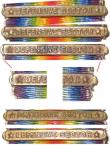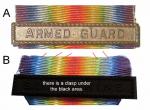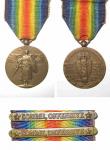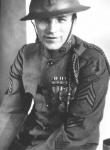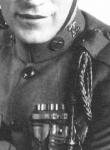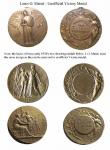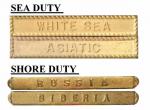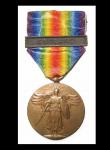-
Posts
461 -
Joined
-
Last visited
Content Type
Profiles
Forums
Blogs
Gallery
Events
Store
Everything posted by johnnymac
-
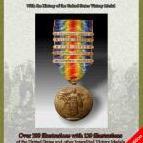
Italian Victory Medals
johnnymac replied to Kev in Deva's topic in Inter-Allied Victory Medals of the Great War
Of course you would use the word elitism, who else would have wasted millions of lives. Elitism is the belief or attitude by individuals who are considered themselves members of a select group of people with superior intellect and wealth. The Officer Corps was made up of mostly wealthy families who conceded "themselves" the "elite". Besides who else in that time period would have purchased a medal gilded, plated or made of solid silver to just enhance it. In the U.S.A. many when to Bailey, Banks and Biddle for the same reason. Rob, Thanks for the info and come back JM -

Italian Victory Medals
johnnymac replied to Kev in Deva's topic in Inter-Allied Victory Medals of the Great War
Since I have never handled one I have no first hand information on it. 1. What would be the reasoning for silver? elitism? 2. Was this one sprayed as it seems the silver is chipping off, and there is not hint of silver in the exposed parts of the bronze. Most illustrations I have seen were plated or as one person listed, it was solid silver? 3. Do you feel it was done in an aftermarket or by the manufacturer? Regards, Johnmac (JM -
The Nixon Matrix has several errors 35th, 80th and 91st is wrong, they are missing St Mihiel clasp. He states that ONLY the 11th Eng. received the Cambrai clasp, he forgot the 12th Eng. On the Russia clasp he wrote "ONLY the FRANCE or RUSSIA" clasp, but he forgot the DEFENSIVE SECTOR clasp if you were a combatant. A battle clasp was prized more than a service clasp. The same is true for SIBERIA with the Defensive Sector clasp. On the 93rd Div.(color troops) it is true they served with the French and were armed with the Label rifles and wore the French accouterments and the French Adrian helmet but they kept their U.S. uniforms.(I have seen 2 photos of WWI colored Veterans from the 369th Inf. at their 10 year reunion, with a sign hung above the stage marked 369th 10th reunion, their Victory medal had 3 clasps.) I could not make out which clasps they were, but I'll bet they were, Champagne-Marne,Meuse-Argonne and the Defensive Sector clasps. Here is a small list of other U.S troops under foreign commands who received their clasps: 1. The 27th & 30th Division after training they remained with the British command during the war. They were issued the No. III Lee Enfield rifle and British accouterments. 2. The 33rd Div 131st Inf., saw action under Australian General Monash. 3. Some of the 80th Div. saw action under Field Marshall Douglas Haig (Somme Offensive). 4. 332nd Inf. was under a Italian Command at Vittori Veneto. 5. The Navy's Grand Fleet was under Admiral Sir David Beatty. Even the 12th & 14 Eng. attached temporarily to theB.E.F. at Cambrai. The 14th Eng. were under U.S.Army Col. Albert Jenkins who states, he was under the command of the British. Nixon's matrix was written 50 years ago, it is good for astart. JohnnyMac
-
Hi, Here are several more possible candidates for your medal with these 5 clasps combo's. All are listed in Battle Participation of Organizations of the A.E.F in France, Belgium & Italy 1917 - 1918. 3rd Field Artillery Brigade, 3rd Ammunition Train (3rd Div). 66th Field Artillery Brigade, 146th & 148 FieldArtillery (41st Div.) were assigned the 2nd Corps. Whereas the 147th F.A. of the 41st Div. was assigned to another unit, that being the 42nd Div. 322nd Field Signal Battalion. 406th Telegraph Battalion. 1st Corps Observation Group, Air Service, 1st Army, 1stSquadron. 3rd Corps Observation Group, Air Service, 1st Army, 88thSquadron. 4th Corps Observation Group, Air Service, 2nd Army, 8thSquadron. 1st Pursuit Group, Air Service, 1st Army, 27th, 94th, 95th& 147th Squadrons. 1st Corps Balloon Group, Air Service, 1st Army, 2nd BalloonCompany. 3rd Corps Balloon Group, Air Service, 1st Army, 3rd BalloonCompany. And I am sure the list goes on. These were Unit awards. Not all members assigned to these units were awards all the listedclasps. JM
-

American (US) Victory Medals
johnnymac replied to Kev in Deva's topic in Inter-Allied Victory Medals of the Great War
I know this is not what you are looking for but if you do not already have this list you may find it interesting. http://www.history.navy.mil/medals/victory/victorya.htm JohnnyMac -
Hi can anyone tell me who the bottom two hallmarks belong too? They are on the French Victory medal, Thanks Regards, JohnnyMac
-

American (US) Victory Medals
johnnymac replied to Kev in Deva's topic in Inter-Allied Victory Medals of the Great War
To Rob, There may have been a misunderstanding in the original manufacturing order and the spacers were later removed before being issued, where-as your being the case where they were missed. You will note that the top three Defensive Sector clasps have a nubs at each end of clasp. Which tells me that at one time there were spacers. Later they were made without the spacer bars, note the bottom two were manufactured without any hint of a spacer bar. Regards, Johnnymac (JM) -

American (US) Victory Medals
johnnymac replied to Kev in Deva's topic in Inter-Allied Victory Medals of the Great War
This is just a starting point: There are many units who received the three clasp you show inyour listing. One of these units is the79th Division. was made up of mostly National Guard units from Maryland &Pennsylvania. In the 79th Division therewere 3 Machine Guns unit assigned to it: 157th Infantry Brigade, 311th Machine Gun Battalion 158th Infantry Brigade, 312th Machine Gun Battalion Divisional Troops: 310th Machine Gun Battalion. Is this the right the unit you are looking, I do not know, but as I said, its a start. The 79th had a bookprinted on it action and the members names might be in it.. check your local Library or ask them toorder it from the main Library. Regards, JohnnyMac (JM)<br style="mso-special-character:line-break"><br style="mso-special-character:line-break"> -

WW1 Victory Medals General Discussion
johnnymac replied to JimZ's topic in Inter-Allied Victory Medals of the Great War
My son was able to find my book in storage boxes at his home, Thanks (JM) -

WW1 Victory Medals General Discussion
johnnymac replied to JimZ's topic in Inter-Allied Victory Medals of the Great War
To all, I need to find The "Gleim Medal Letters 1971-1997", Extracts D35 & D36 and these two pages 88-89. Would someone please post these. Thanks, JohnnyMac (JM) -

American (US) Victory Medals
johnnymac replied to Kev in Deva's topic in Inter-Allied Victory Medals of the Great War
Changing subject for moment To all, Need a little help here, This is my own Navy medal (A) and as you can see it has an official ribbon and clasp. Also you can see that the thread colors flow continuously from one side to the other and it shows proper aging. But, (B) I have been seeing more and more of this broken thread type ribbon on Vic's with official clasps on them. All example I have seen show corner wear but not true aging. My question is, is there any info on this ribbon. Thanks Johnnymac (JM) -

Romanian Victory Medals
johnnymac replied to Kev in Deva's topic in Inter-Allied Victory Medals of the Great War
Hello Tim I did this in a black and white to help you see it a littler clearer. And I agree with all the Rob just posted on the Romanian Vic. Johnmymac (JM) -

American (US) Victory Medals
johnnymac replied to Kev in Deva's topic in Inter-Allied Victory Medals of the Great War
-

American (US) Victory Medals
johnnymac replied to Kev in Deva's topic in Inter-Allied Victory Medals of the Great War
To Rob, If the French collectors do not feel that they are French made, then who do they think made your style clasps? If you examine my photo you will note that all three clasps have different type stars yet all three are of the same quality, and the same lettering style. They are not Bailey, Banks, & Biddle Co., as they stamped everything with their hallmark. They are not U.S. issue nor are they from the U.S. Mint. So that leaves us with either Czech or maybe Italy if they are not French made. We know that the French were producing early repros of the battle and we know they also did a series listing unauthorized campaign clasps for sale to the Veterans, mainly U.S. Veterans. Looking at Laslo's U.S. Repro 1a, figure 118, page 86, I found that these clasps plus this medal might be a good match as I have both the medal and the clasps. When you put them side by side you can see the color and the quality are the same. Is this the final word no but I feel it is a good place to start. JM Question is Alex Laslo still alive and if so, does he have a web site. -

American (US) Victory Medals
johnnymac replied to Kev in Deva's topic in Inter-Allied Victory Medals of the Great War
Off subject just for a moment. To All I need some help on identifying: 1) The other collar insignia next to the collar disk with crossed cannons. 2) Also the eagle to the right of the Victory medal. 3) Last the medal to the left of the Victory medal and the 2 ribbons above. I just purchased this photo and it is signed by a Sgt. Alex Arch, 6th Field Artillery, 1St Division. He was credited pulling the lanyard on a French 75mm and firing the first U.S. Artillery piece in WWI for the AEF. Thanks JM http://gmic.co.uk/uploads/monthly_06_2010/post-8368-127689646284.jpghttp://gmic.co.uk/uploads/monthly_06_2010/post-8368-127689647636.jpg -

Japanese Victory Medals
johnnymac replied to Tim B's topic in Inter-Allied Victory Medals of the Great War
I am changing subject for moment. I believe there is a Japanese Vic repro on ebay which someone filed the ball suspension down to make it look like a barrel shape suspension. It has a cut off repro ribbon, and if you do a zoom in on the reverse you too might notice it. I am sure the dealer has not seen it or he would have mentioned it. Auction off ending in 5 days. Today is May 23. Check it out by typing in "victory medal", "worldwide" and let me know what you think? JM -
Tim I do agree with all that you say. When I bid on an item I always ask for a better photo, if the item is not shown properly, but in this case it was as plain as day. Last, I will add the seller did give them a way out with his great photos. But on the other hand, might it have been his way out “Hey, I sent you what I posted”! Regards (JM)
-
To All First – The bidders were mainly new collectors, with bids on ebay as low as 9, 77, and 180. The one with 180 bids paid the outrageous price on the bogus Romania & Portuguese medal. One bidder, who has 3475 bids on ebay, did bid $256.55. This I do not understand, unless of course he had won and then changed his mind, there is the "second offer thing on ebay", if you get my point. Second – The seller "did" list some correctly. But check out the item description on each medal sold by this seller on this group. He did a copy and paste on his whole full page Ad. But in the "item description", in some medals a key word or two is missing, like in the case of the Portuguese and Romanian, which tell me a lot. Third – The two Questions I asked myself, would not the 50 year collector have told him which ones were good, and which ones were not? And why, did not, the 50 year collector auction them himself? Forth - The Romanian and the Portuguese medals may have been driven but the lack of the availability of Laslo's book. Fifth - I hate to touch on Laslo's book, but he put so much time into his writing and not enough time in his photographs. How many times have we heard that old saying "A picture is worth a thousand words". A new collector even with Laslo's book may not see the fine lines between official, reissue, unofficial and in some cases "Repros" Last - I can where new collectors trusting a seller with over 5700 sales, selling a 50 year collector's collection might go wrong. At least this time it was not "Estate Sale", chuckle, chuckle. JM (Johnnymac)
-

British Victory Medals
johnnymac replied to Kev in Deva's topic in Inter-Allied Victory Medals of the Great War
CQMS - Company QuarterMaster Sergeant http://acronyms.thefreedictionary.com/CQMS -
Hi Chris The thickness of the ribbon itself, plus the ball suspension overall width, would negate the need for a uniface medal (reverse side) to fit into a frame. Might it be just a supply of M. Pautot surplus medals sold on the open market? Or, an enterprising person, or M. Pautot himself who saw a large market with the veterans who might want a framed medal? Left blank as it is, it seems to me that a veteran could have some inscription put on it, like a name, battles, dates etc. and that in itself would be a big marketing tool for this type of medal. L. O. Mattei found a market for his half of the unofficial type 2 medal "listed in Laslo's" book" by using it for shooting match medals "Concours De Tir" held in France during early 1920's. See illustration of L.O. Mattei medal below regards, Johnnymac (JM)
-

American (US) Victory Medals
johnnymac replied to Kev in Deva's topic in Inter-Allied Victory Medals of the Great War
Hello Bosungus SEA DUTY RUSSIA and SIBERIA: "For service on any vessel" which made a Russian port during such service from 06 April 1917 to 11 Nov. 1918, or any combatant ship in a Russian port on the White Sea not less than 10 days from 12 Nov. 1918 to 31 July 1919. SHORE DUTY Up to 1933 the naval personnel on shore duty in Russia & Siberia were only awarded the Victory medal, no clasp/bar. In 1933, the Navy extended the "Army's" Russia and Siberia service clasps to naval personnel, "For service on shore" in Northern Russia & Siberia, from 12 November 1918 to 31 July 1919. Does this help, JM (JohnnyMac) -

American (US) Victory Medals
johnnymac replied to Kev in Deva's topic in Inter-Allied Victory Medals of the Great War
-

American (US) Victory Medals
johnnymac replied to Kev in Deva's topic in Inter-Allied Victory Medals of the Great War
Here some of my notes I keep, I hope it helps: This clasp is a Gleim FI type (Unknown Manufacturer) and as of this date there is no information on it being an authorized clasp. NAVY SERVICE CLASPS Bureau of Navigation Circular Letter No. 36-20 of 23 April 1920 announced provisions for issuing the Victory Medal, adding that honorable character of service was a precondition for award of the Victory Medal. Recipients were authorized to have engraved on the rim his or her name, rank and the name of the ship or station where he or she served during the war, (There are many examples of the engraving on the face of the medal, which is obviously a misunderstanding of the owner or the engraver of the stated order). In 1933, the Navy extended the (Army's) Russia and Siberia service clasps to naval personnel for duty in the following timeframe: RUSSIA: For service on shore in Northern Russia from 12 November 1918 to 31 July 1919. SIBERIA: For service on shore in Siberia from 12 November 1918 to 30 March 1920, both Army style clasps Seven years later, on 05 October 1940, the Secretary of the Navy authorized the award of the (Army's) FRANCE, ENGLAND and ITALY service clasps to personnel of the Navy and Marine Corps who sailed from the U.S. prior to 11 Nov. 1918 enroute to one of these countries, regardless of their date of arrival in that country -- even if those personnel were returned to the U.S. without disembarking. The first formal assignment of clasps was contained in General Order No. 528 of 25 April 1920. Curiously, it also made reference to clasps HOSPITAL SHIP and GUNBOAT, devices never authorized or officially struck. By 1953, the Navy and Marine Corps Awards Manual specified clasps for approximately 1,388 ships, 140 of these vessels qualified for two different clasps and two ships qualified for three clasps. Again, a recipient could wear only one earned Navy clasp. The thousands of Marines and Navy Medical Corps personnel attached to the Army in France earned and were authorized to wear those (Army) clasps authorized by their parent command. When any person had been commended as the result of the recommendation of the Board of Awards by the Secretary of the Navy for performance of duty during World War I not justifying the award of a Medal of Honor, a Distinguished Service Medal, or a Navy Cross, he or she shall wear a 3/16-inch silver star on the suspension ribbon and ribbon bar for each such citation. A bronze Maltese cross, 3/16-inch in diameter, was to be placed on the service ribbon of those officers and men of the Marine Corps and Medical Corps, United States Navy, who were attached to the American Expeditionary Forces in France any time between 6 April 1917, and 11 November 1918, and who are not entitled to any battle clasp provided for by General Order No. 83, War Department, 30 June 1919. JM -

American (US) Victory Medals
johnnymac replied to Kev in Deva's topic in Inter-Allied Victory Medals of the Great War
To All, Battle Participation of Organizations of the American Expeditionary Forces in France Belgium and Italy 1917-1918 (Paperback)</SPAN> $16.98 USD http://www.amazon.co...64678834&sr=1-1 JM




